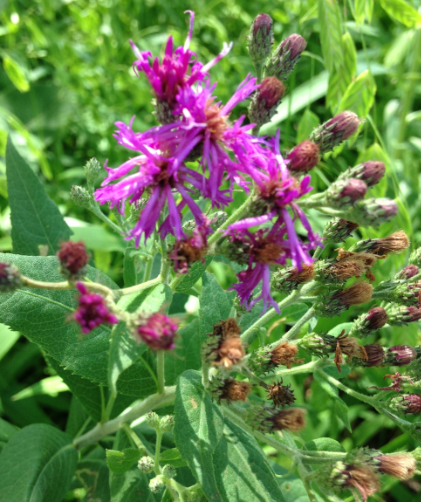Here at the Dyck Arboretum it can be a tricky task deciding what is a weed to be pulled and what should be allowed to grow on. Many of our beloved volunteers look to me for guidance when they encounter a plant that looks out of place. What is a weed here?
Many wonderful prairie plants carry the misnomer of “weed”, such as butterfly weed, iron weed, and milkweed. These are plants that may or may not need to be pulled, depending on where they are located. I consider a few factors: does the plant belong here or fit the theme of that garden bed? Is it annual or perennial? Will it become invasive? Is it part of a plant family that is notorious for colonizing? …and so on. Weeding will become less of a guessing game when you learn to identify some native species and particularly those nasty exotics.

While the name ‘milkweed’ might cause you to shun this plant for your garden, think before you pull! In the right area, milkweeds may be a perfect addition. They will bloom for several weeks and add a bit of important monarch habitat to your backyard. Photos from Dyck Arboretum.
“Where do they come from and how can I beat them?”
Just when you think you have weeded every last square inch of your garden, here they come again. The seed bank – dormant seed that exists in the top soil – will continue to produce more weeds as long as conditions are favorable. Seeds can lay dormant in the soil for long periods of time, waiting for adequate moisture and light levels. Bindweed seed can remain viable in the soil for up to 50 years! The seed bank is created by last year’s mature weed seeds, bird droppings, hay/manure used for mulching, and seeds carried on the wind. The good news? With regular weeding and mindful practices you will decrease your weed seed bank every year. That means pulling weeds before they seed, using carefully sourced mulch material, and disturbing the soil as infrequently as possible to reduce the amount of dormant seeds awakened by light and oxygen.
Some weeds are obvious
Bindweed with it’s morning glory bloom, Siberian Elm saplings with their small serrated leaves, and prostrate spurge with its circular, flat habit all send up the red flag. These kinds of plants look out of place right away because they lack charisma and often grow in inhospitable areas. (i.e. in driveway cracks and gravel, climbing up stems of other plants).
Some weeds are ambiguous
Virginia creeper vine seems to crop up everywhere, and are very decorative if left to grow in a good spot. But they can also be aggressive when not trimmed regularly. Similarly, a mulberry sprout (which tend to come up just about everywhere a bird flies over), could be left to grow into a nice fruiting tree if you are prepared for the berry-mess and seed spread. Plants like ironweed and Illinois bundleflower seem to pop up everywhere and, though they can be aggressive spreaders, they are also quite attractive.

Ironweed (Vernonia sp.) may at first appear as an intruder, but it produces a long lasting bloom and is visited by many species of bees. Photo from Dyck Arboretum.
Some weeds are not weeds at all
I always advocate for leaving milkweed in the garden as habitat for monarchs. Lucky you if a few come up! Other species like purple poppy mallow and wild petunia that may appear weedy at first actually make well behaved native specimens. These species bloom all summer long and are extremely drought tolerant.
While you pull and pluck away at the weeds in the garden, remember the wise words of the poet Ella Wheeler Wilcox – “A weed is but an unloved flower”. Although weeding is the tedious task all of us gardeners must endure, you can make it easier and more productive by knowing the difference between potential friend and foe.
